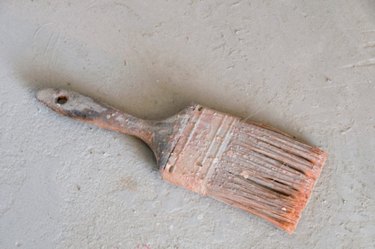Things You'll Need
Soap and water
Rubber gloves
Green scrubbing pad
Solvent
TSP
Old fork
2 solvent cans
Cheesecloth

One of the less pleasant tasks when painting involves cleaning the paint brush. Paint brushes get very messy, and often, the cleaning products to remove the paint are solvents that require special handling. But it's worth it; a good paintbrush is expensive, and when a good paintbrush is well taken care of, it can last a long time. One product you can use to help maintain your brush in good order is TSP (trisodium phosphate).
Step 1
Wash the paint brush using soap and water. It's best to use a bucket, rather than your sink. Petroleum-based soaps are more effective on most water-based paints. Wear rubber gloves. Scrub the handle and metal brush surround using a green scrubber brush. Knead the paint bristles with your fingers to spread and separate the bristles, and press soap between the bristles. Work from the handle side toward the brush tips.
Video of the Day
Step 2
Clean a solvent-based paint brush by soaking the brush in the solvent type recommended by the manufacturer of the paint you're using. Typically, this may be alcohol-based for shellac, lacquer thinner for lacquer, acetone, xylene or other oil and varnish removers. Wear rubber gloves. Scrub the handle, and metal brush surround using a rag. Knead the paint bristles with your fingers to spread and separate the bristles, and press solvent between the bristles. Work from the handle side toward the brush tips.
Step 3
Mix TSP (trisodium phosphate) granules in a small disposable container with water. This mixture is suitable for cleaning both water- and oil-based paints from brushes, and it can often be used after the first stage of cleaning is complete. TSP is considered the old-standby brush cleaner. Some brands of TSP also contain ammonia. Use a higher ratio of TSP if your brush is particularly dirty, or if it has old paint hardened in the bristles. Different ratios are posted on the back of the product. Soak the brush for the time recommended on the product packaging.
Step 4
Press an old fork into the bristles near the metal and drag the fork toward the ends of the bristles. This will help open the bristles so the TSP can get deeper into the bristles. The fork will also drag old paint out of the brush. Work your way across the brush on both sides until the majority of the old paint is gone. Dry the brush on a clean rag and hang it.
Step 5
Spread cheesecloth over an empty paint can. Pour the solvent used in Step 2 through the cheesecloth into the empty can. This will remove a lot of the contaminants. Leave the lid off the first can that now only has cleaning remains. Place a lid and label the used solvent for later cleaning use. Dispose of the first can as recommended by your sanitation department.
Tip
TSP works best in combination with traditional cleaning methods, particularly when a paint brush is used many days in a row. Ask your local disposal company how to dispose of water-based brush cleaning solutions in your area. No solvent-based brush cleaning solutions should ever be poured into household drains. Always dispose of these products and product soaked rags as recommended by your local disposal and waste company.
Video of the Day